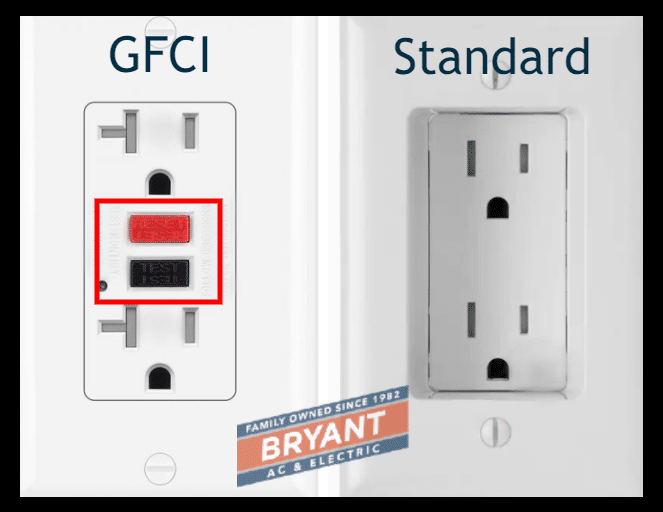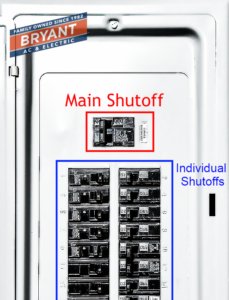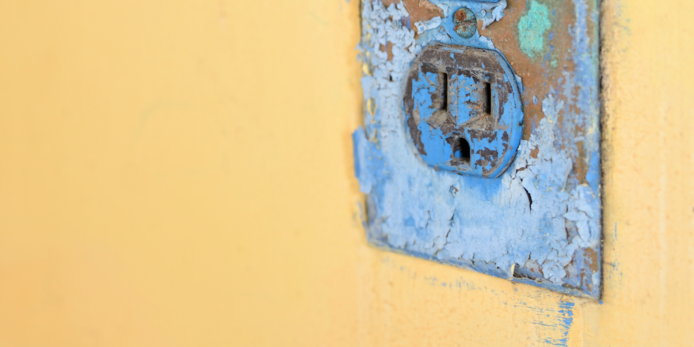Wet electrical outlets pose a serious risk in your home. Taking immediate steps can reduce risks and allow you time to replace or repair the affected outlet. These tips can help you decide how to manage a wet outlet in your home.
Quick-check list:
What should I do if my electrical outlet gets wet?
- Shut off your GCFI outlet – To shut off a wet GFCI outlet manually, press the reset and test buttons simultaneously
- Shut off the breaker – Shutting the power off at the breaker box is recommended when you have a wet outlet, even if the outlet is GFCI-rated and has already stopped working
- Dry the outlet – a small splash of water can dry on its own, however, in severe cases, like flooding, you should contact a professional, licensed Austin electrician to evaluate the damage and make repairs
Scroll down for more in-depth answers and information about air conditioner units

GFCI Outlet Shutoff
GFCI, or ground fault circuit interrupter, outlets are designed to shut off when the flow of electric is interrupted. The shutoff is automatic and can occur when small amounts of water, such as humidity in the bathroom, enters the outlet.
Turning the outlet off can help prevent water damage caused by excess humidity. To shut off a wet GFCI outlet manually, press the reset and test buttons simultaneously. Test the outlet with a voltage meter to ensure the outlet is off. More severe water damage requires taking additional steps.
Water causes an interruption that makes the outlet quit working, but the wires connected to the outlet may carry a live electrical current. The live current poses both an electrocution hazard and a fire risk. To minimize risks, you need to turn the power off at the breaker box as quickly as possible.
Breaker Box Shutoff
Shutting the power off at the breaker box is recommended when you have a wet outlet, even if the outlet is GFCI-rated and has already stopped working. If your breakers are labeled, just flip the appropriate breaker to the off position to stop the electrical current from flowing to the wet outlet.
Unlabeled breakers require flipping the breakers off until you find the right one. Test the outlet with a voltage meter to ensure the right breaker is turned off, or call a professional for assistance in finding the right breaker. Do not remove, use, or repair the outlet if you aren’t positive the appropriate breaker is switched to the off position.
If several outlets have water damage, consider turning the power off at the main breaker. The main breaker is typically located in a breaker box on your electric pole. Do not attempt to flip the main breaker unless you are familiar with its location to prevent potentially serious injuries.

Warning – Not all breakers may be set up like this example image. If you are unsure what to do, in the event of an electrical issue or emergency, please contact a professional, licensed electrician.
Should My AC Unit Be Wet?
While air conditioner units do sometimes drip water due to condensation, they should not be dripping water onto an outlet or into sensitive areas of the unit. Because condensation is expected, you must be extra careful to ensure that your AC system is set up correctly and will not become an electrical hazard. If you live in the Austin area, the team at Bryant Electric & AC is well versed in electrical and AC maintenance, so you can rest assured knowing that your tech can handle any problems, whether it has to do with your cooling system or electrical setup.
You can check out our Air Conditioning page to learn more.
How to Dry Out an Outlet
Typically, it is best to replace outlets that are damaged by water, especially when outlets exposed to significant amounts of water. If your home is flooded, consider turning the power off at the main breaker until the damage is professionally assessed.
If you need further assistance, the Austin electricians at Bryant Electric Services can help you assess the damage and make the necessary repairs for a safer home electrical system. Contact us today or use our easy job scheduler to reserve an appointment:
Schedule Service


